Cross-Cultural Management Report: Sweden and Ethiopia Comparison
VerifiedAdded on 2021/06/14
|14
|3416
|71
Report
AI Summary
This report provides a comprehensive analysis of cross-cultural management, focusing on a comparative study between Sweden and Ethiopia. It begins with an introduction to the concept of culture and its significance in a globalized world, highlighting how cultural differences impact various aspects of society. The report then delves into the cultural dimensions of Sweden and Ethiopia using Hofstede's model, examining power distance, individualism, masculinity, uncertainty avoidance, long-term orientation, and indulgence. It contrasts the two countries across these dimensions, revealing significant differences in societal values and norms. Furthermore, the report explores the leadership styles prevalent in both nations, referencing the GLOBE research program and discussing charismatic/value-based, team-based, participative, humane-oriented, autonomous, and self-protective leadership approaches. The analysis extends to communication styles, drawing upon Edward T. Hall's framework to compare the two countries' approaches to context, time, and non-verbal communication. The report concludes by summarizing the key findings and implications of the cultural differences between Sweden and Ethiopia, offering insights for effective cross-cultural management and communication strategies.
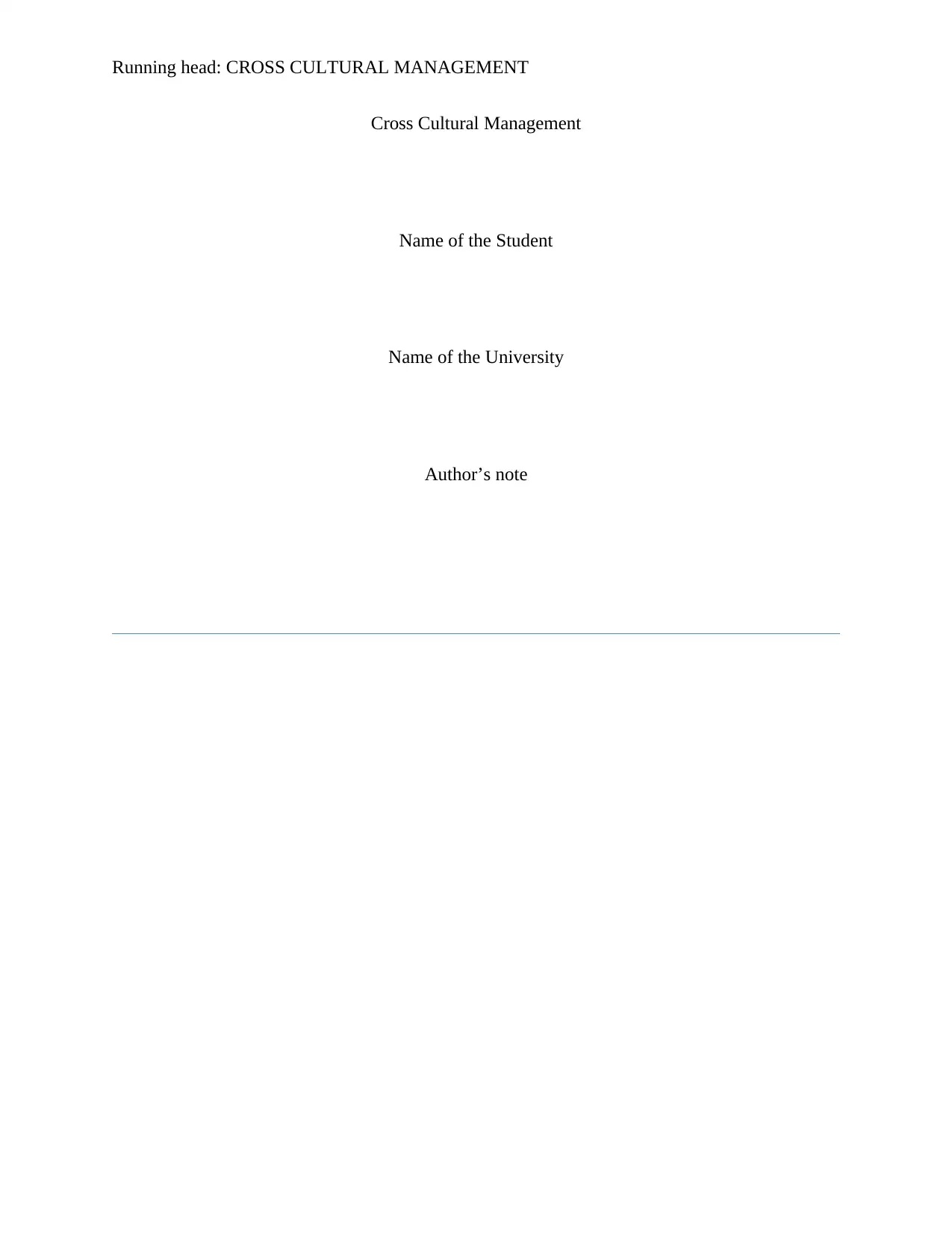
Running head: CROSS CULTURAL MANAGEMENT
Cross Cultural Management
Name of the Student
Name of the University
Author’s note
Cross Cultural Management
Name of the Student
Name of the University
Author’s note
Paraphrase This Document
Need a fresh take? Get an instant paraphrase of this document with our AI Paraphraser
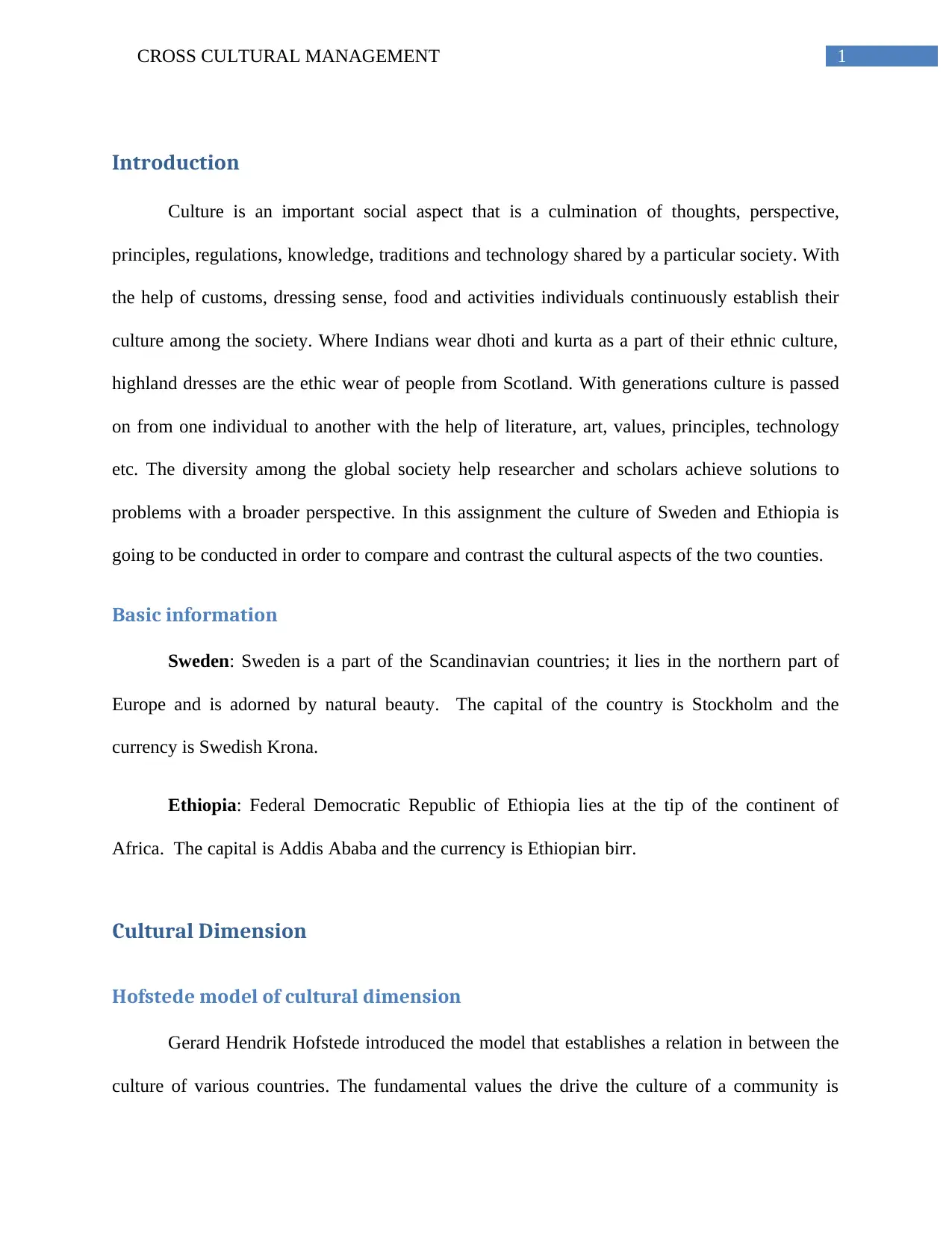
1CROSS CULTURAL MANAGEMENT
Introduction
Culture is an important social aspect that is a culmination of thoughts, perspective,
principles, regulations, knowledge, traditions and technology shared by a particular society. With
the help of customs, dressing sense, food and activities individuals continuously establish their
culture among the society. Where Indians wear dhoti and kurta as a part of their ethnic culture,
highland dresses are the ethic wear of people from Scotland. With generations culture is passed
on from one individual to another with the help of literature, art, values, principles, technology
etc. The diversity among the global society help researcher and scholars achieve solutions to
problems with a broader perspective. In this assignment the culture of Sweden and Ethiopia is
going to be conducted in order to compare and contrast the cultural aspects of the two counties.
Basic information
Sweden: Sweden is a part of the Scandinavian countries; it lies in the northern part of
Europe and is adorned by natural beauty. The capital of the country is Stockholm and the
currency is Swedish Krona.
Ethiopia: Federal Democratic Republic of Ethiopia lies at the tip of the continent of
Africa. The capital is Addis Ababa and the currency is Ethiopian birr.
Cultural Dimension
Hofstede model of cultural dimension
Gerard Hendrik Hofstede introduced the model that establishes a relation in between the
culture of various countries. The fundamental values the drive the culture of a community is
Introduction
Culture is an important social aspect that is a culmination of thoughts, perspective,
principles, regulations, knowledge, traditions and technology shared by a particular society. With
the help of customs, dressing sense, food and activities individuals continuously establish their
culture among the society. Where Indians wear dhoti and kurta as a part of their ethnic culture,
highland dresses are the ethic wear of people from Scotland. With generations culture is passed
on from one individual to another with the help of literature, art, values, principles, technology
etc. The diversity among the global society help researcher and scholars achieve solutions to
problems with a broader perspective. In this assignment the culture of Sweden and Ethiopia is
going to be conducted in order to compare and contrast the cultural aspects of the two counties.
Basic information
Sweden: Sweden is a part of the Scandinavian countries; it lies in the northern part of
Europe and is adorned by natural beauty. The capital of the country is Stockholm and the
currency is Swedish Krona.
Ethiopia: Federal Democratic Republic of Ethiopia lies at the tip of the continent of
Africa. The capital is Addis Ababa and the currency is Ethiopian birr.
Cultural Dimension
Hofstede model of cultural dimension
Gerard Hendrik Hofstede introduced the model that establishes a relation in between the
culture of various countries. The fundamental values the drive the culture of a community is

2CROSS CULTURAL MANAGEMENT
recognized in terms of country and thus helps in establishing a contrast among the diverse
culture that is prevalent around the world. He has provided five value factors to recognize
national and regional cultural difference. Many business organisations used this model to
understand the cultural difference in between countries while they plan on expanding the
business in the international market (Zhao 2013).
Following is the analysis of Sweden and Ethiopia.
Figure: Comparison of Culture in Hofstede model
(Source: Hofstede-insights.com 2018)
Power distance: this is the aspect which is explained as the perspectives of the society towards
inequalities among the individual as this dimension is based on the concept that people are not
equal. It can be seen in the above image that Ethiopia scores 70 on the power distance index.
recognized in terms of country and thus helps in establishing a contrast among the diverse
culture that is prevalent around the world. He has provided five value factors to recognize
national and regional cultural difference. Many business organisations used this model to
understand the cultural difference in between countries while they plan on expanding the
business in the international market (Zhao 2013).
Following is the analysis of Sweden and Ethiopia.
Figure: Comparison of Culture in Hofstede model
(Source: Hofstede-insights.com 2018)
Power distance: this is the aspect which is explained as the perspectives of the society towards
inequalities among the individual as this dimension is based on the concept that people are not
equal. It can be seen in the above image that Ethiopia scores 70 on the power distance index.
⊘ This is a preview!⊘
Do you want full access?
Subscribe today to unlock all pages.

Trusted by 1+ million students worldwide
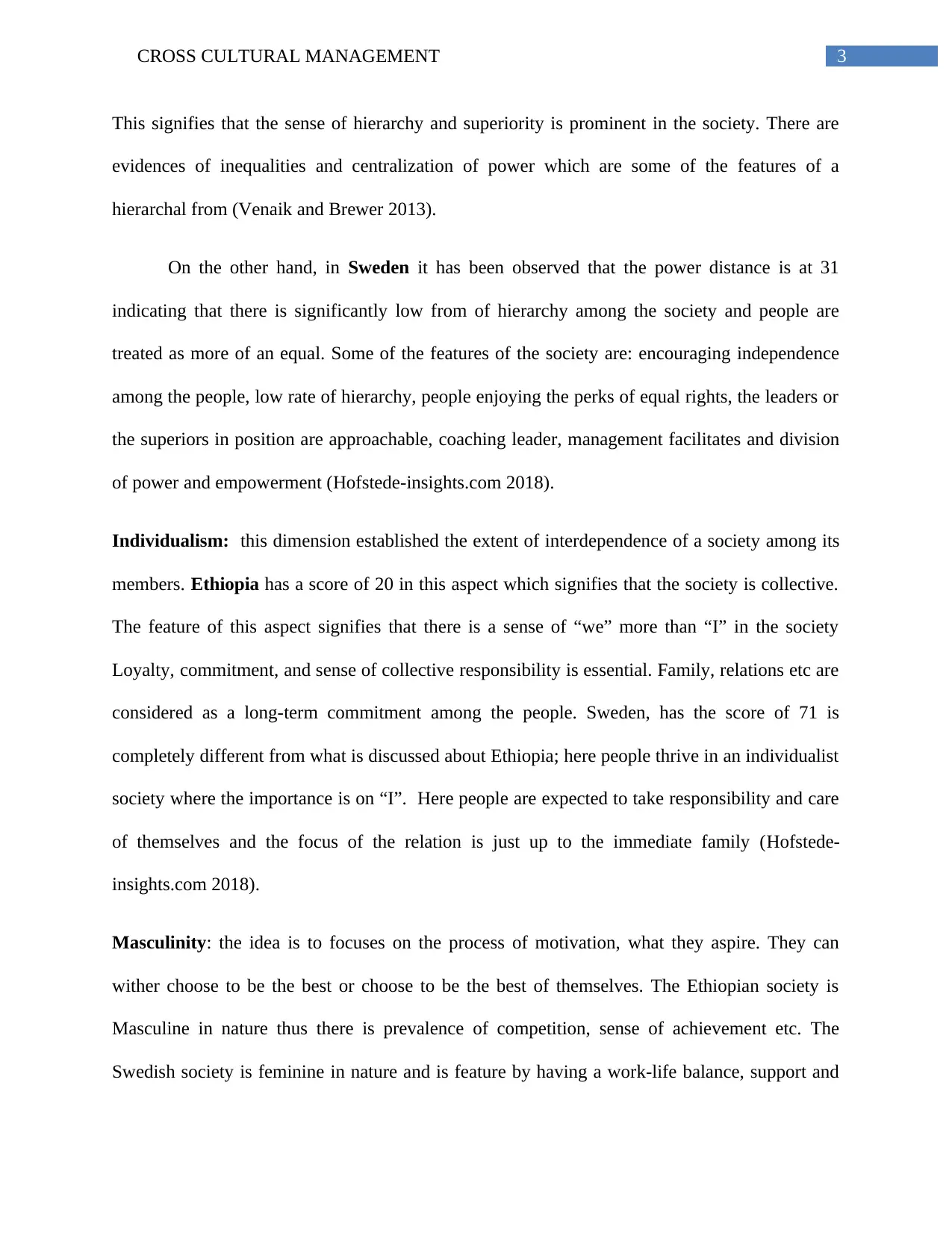
3CROSS CULTURAL MANAGEMENT
This signifies that the sense of hierarchy and superiority is prominent in the society. There are
evidences of inequalities and centralization of power which are some of the features of a
hierarchal from (Venaik and Brewer 2013).
On the other hand, in Sweden it has been observed that the power distance is at 31
indicating that there is significantly low from of hierarchy among the society and people are
treated as more of an equal. Some of the features of the society are: encouraging independence
among the people, low rate of hierarchy, people enjoying the perks of equal rights, the leaders or
the superiors in position are approachable, coaching leader, management facilitates and division
of power and empowerment (Hofstede-insights.com 2018).
Individualism: this dimension established the extent of interdependence of a society among its
members. Ethiopia has a score of 20 in this aspect which signifies that the society is collective.
The feature of this aspect signifies that there is a sense of “we” more than “I” in the society
Loyalty, commitment, and sense of collective responsibility is essential. Family, relations etc are
considered as a long-term commitment among the people. Sweden, has the score of 71 is
completely different from what is discussed about Ethiopia; here people thrive in an individualist
society where the importance is on “I”. Here people are expected to take responsibility and care
of themselves and the focus of the relation is just up to the immediate family (Hofstede-
insights.com 2018).
Masculinity: the idea is to focuses on the process of motivation, what they aspire. They can
wither choose to be the best or choose to be the best of themselves. The Ethiopian society is
Masculine in nature thus there is prevalence of competition, sense of achievement etc. The
Swedish society is feminine in nature and is feature by having a work-life balance, support and
This signifies that the sense of hierarchy and superiority is prominent in the society. There are
evidences of inequalities and centralization of power which are some of the features of a
hierarchal from (Venaik and Brewer 2013).
On the other hand, in Sweden it has been observed that the power distance is at 31
indicating that there is significantly low from of hierarchy among the society and people are
treated as more of an equal. Some of the features of the society are: encouraging independence
among the people, low rate of hierarchy, people enjoying the perks of equal rights, the leaders or
the superiors in position are approachable, coaching leader, management facilitates and division
of power and empowerment (Hofstede-insights.com 2018).
Individualism: this dimension established the extent of interdependence of a society among its
members. Ethiopia has a score of 20 in this aspect which signifies that the society is collective.
The feature of this aspect signifies that there is a sense of “we” more than “I” in the society
Loyalty, commitment, and sense of collective responsibility is essential. Family, relations etc are
considered as a long-term commitment among the people. Sweden, has the score of 71 is
completely different from what is discussed about Ethiopia; here people thrive in an individualist
society where the importance is on “I”. Here people are expected to take responsibility and care
of themselves and the focus of the relation is just up to the immediate family (Hofstede-
insights.com 2018).
Masculinity: the idea is to focuses on the process of motivation, what they aspire. They can
wither choose to be the best or choose to be the best of themselves. The Ethiopian society is
Masculine in nature thus there is prevalence of competition, sense of achievement etc. The
Swedish society is feminine in nature and is feature by having a work-life balance, support and
Paraphrase This Document
Need a fresh take? Get an instant paraphrase of this document with our AI Paraphraser
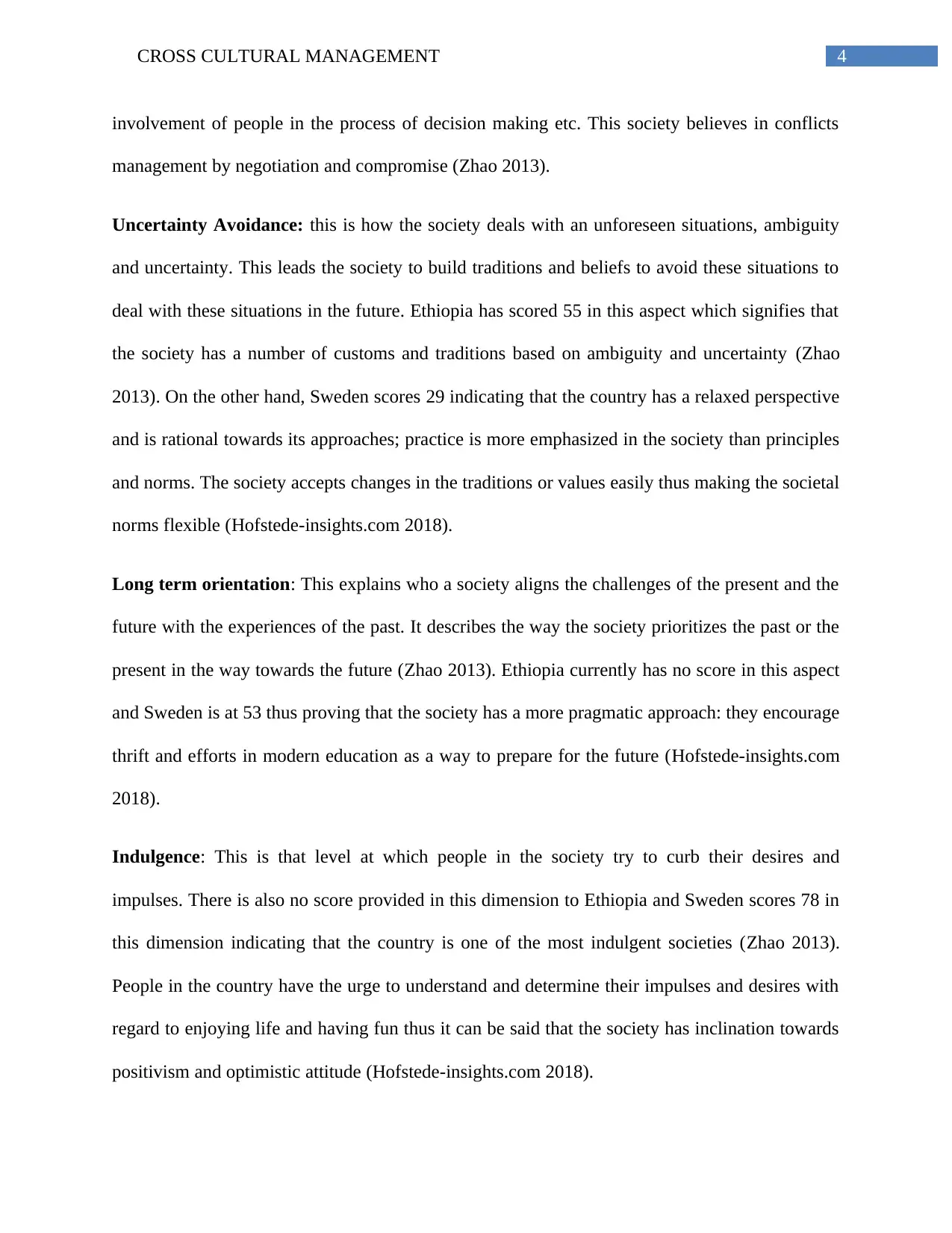
4CROSS CULTURAL MANAGEMENT
involvement of people in the process of decision making etc. This society believes in conflicts
management by negotiation and compromise (Zhao 2013).
Uncertainty Avoidance: this is how the society deals with an unforeseen situations, ambiguity
and uncertainty. This leads the society to build traditions and beliefs to avoid these situations to
deal with these situations in the future. Ethiopia has scored 55 in this aspect which signifies that
the society has a number of customs and traditions based on ambiguity and uncertainty (Zhao
2013). On the other hand, Sweden scores 29 indicating that the country has a relaxed perspective
and is rational towards its approaches; practice is more emphasized in the society than principles
and norms. The society accepts changes in the traditions or values easily thus making the societal
norms flexible (Hofstede-insights.com 2018).
Long term orientation: This explains who a society aligns the challenges of the present and the
future with the experiences of the past. It describes the way the society prioritizes the past or the
present in the way towards the future (Zhao 2013). Ethiopia currently has no score in this aspect
and Sweden is at 53 thus proving that the society has a more pragmatic approach: they encourage
thrift and efforts in modern education as a way to prepare for the future (Hofstede-insights.com
2018).
Indulgence: This is that level at which people in the society try to curb their desires and
impulses. There is also no score provided in this dimension to Ethiopia and Sweden scores 78 in
this dimension indicating that the country is one of the most indulgent societies (Zhao 2013).
People in the country have the urge to understand and determine their impulses and desires with
regard to enjoying life and having fun thus it can be said that the society has inclination towards
positivism and optimistic attitude (Hofstede-insights.com 2018).
involvement of people in the process of decision making etc. This society believes in conflicts
management by negotiation and compromise (Zhao 2013).
Uncertainty Avoidance: this is how the society deals with an unforeseen situations, ambiguity
and uncertainty. This leads the society to build traditions and beliefs to avoid these situations to
deal with these situations in the future. Ethiopia has scored 55 in this aspect which signifies that
the society has a number of customs and traditions based on ambiguity and uncertainty (Zhao
2013). On the other hand, Sweden scores 29 indicating that the country has a relaxed perspective
and is rational towards its approaches; practice is more emphasized in the society than principles
and norms. The society accepts changes in the traditions or values easily thus making the societal
norms flexible (Hofstede-insights.com 2018).
Long term orientation: This explains who a society aligns the challenges of the present and the
future with the experiences of the past. It describes the way the society prioritizes the past or the
present in the way towards the future (Zhao 2013). Ethiopia currently has no score in this aspect
and Sweden is at 53 thus proving that the society has a more pragmatic approach: they encourage
thrift and efforts in modern education as a way to prepare for the future (Hofstede-insights.com
2018).
Indulgence: This is that level at which people in the society try to curb their desires and
impulses. There is also no score provided in this dimension to Ethiopia and Sweden scores 78 in
this dimension indicating that the country is one of the most indulgent societies (Zhao 2013).
People in the country have the urge to understand and determine their impulses and desires with
regard to enjoying life and having fun thus it can be said that the society has inclination towards
positivism and optimistic attitude (Hofstede-insights.com 2018).
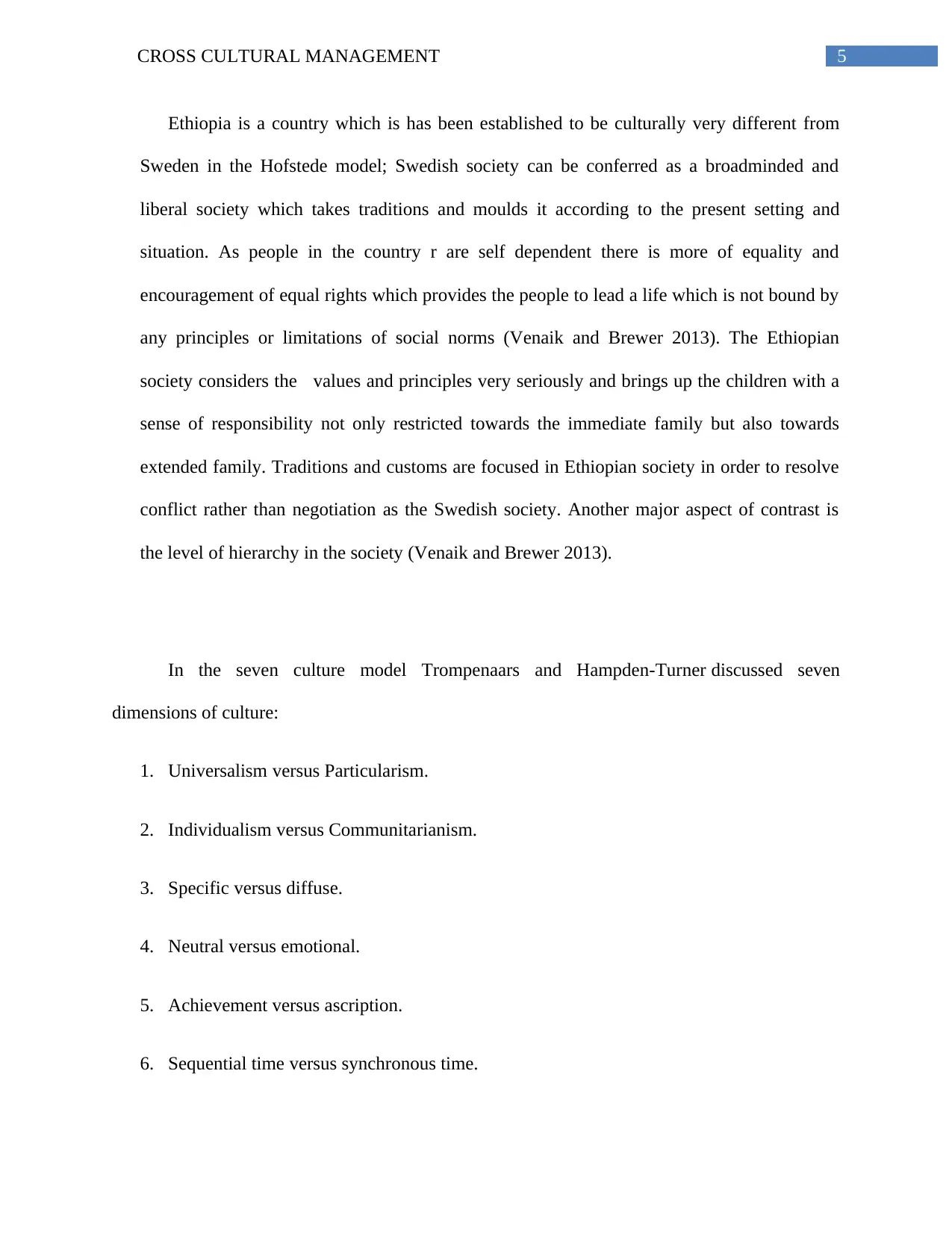
5CROSS CULTURAL MANAGEMENT
Ethiopia is a country which is has been established to be culturally very different from
Sweden in the Hofstede model; Swedish society can be conferred as a broadminded and
liberal society which takes traditions and moulds it according to the present setting and
situation. As people in the country r are self dependent there is more of equality and
encouragement of equal rights which provides the people to lead a life which is not bound by
any principles or limitations of social norms (Venaik and Brewer 2013). The Ethiopian
society considers the values and principles very seriously and brings up the children with a
sense of responsibility not only restricted towards the immediate family but also towards
extended family. Traditions and customs are focused in Ethiopian society in order to resolve
conflict rather than negotiation as the Swedish society. Another major aspect of contrast is
the level of hierarchy in the society (Venaik and Brewer 2013).
In the seven culture model Trompenaars and Hampden-Turner discussed seven
dimensions of culture:
1. Universalism versus Particularism.
2. Individualism versus Communitarianism.
3. Specific versus diffuse.
4. Neutral versus emotional.
5. Achievement versus ascription.
6. Sequential time versus synchronous time.
Ethiopia is a country which is has been established to be culturally very different from
Sweden in the Hofstede model; Swedish society can be conferred as a broadminded and
liberal society which takes traditions and moulds it according to the present setting and
situation. As people in the country r are self dependent there is more of equality and
encouragement of equal rights which provides the people to lead a life which is not bound by
any principles or limitations of social norms (Venaik and Brewer 2013). The Ethiopian
society considers the values and principles very seriously and brings up the children with a
sense of responsibility not only restricted towards the immediate family but also towards
extended family. Traditions and customs are focused in Ethiopian society in order to resolve
conflict rather than negotiation as the Swedish society. Another major aspect of contrast is
the level of hierarchy in the society (Venaik and Brewer 2013).
In the seven culture model Trompenaars and Hampden-Turner discussed seven
dimensions of culture:
1. Universalism versus Particularism.
2. Individualism versus Communitarianism.
3. Specific versus diffuse.
4. Neutral versus emotional.
5. Achievement versus ascription.
6. Sequential time versus synchronous time.
⊘ This is a preview!⊘
Do you want full access?
Subscribe today to unlock all pages.

Trusted by 1+ million students worldwide
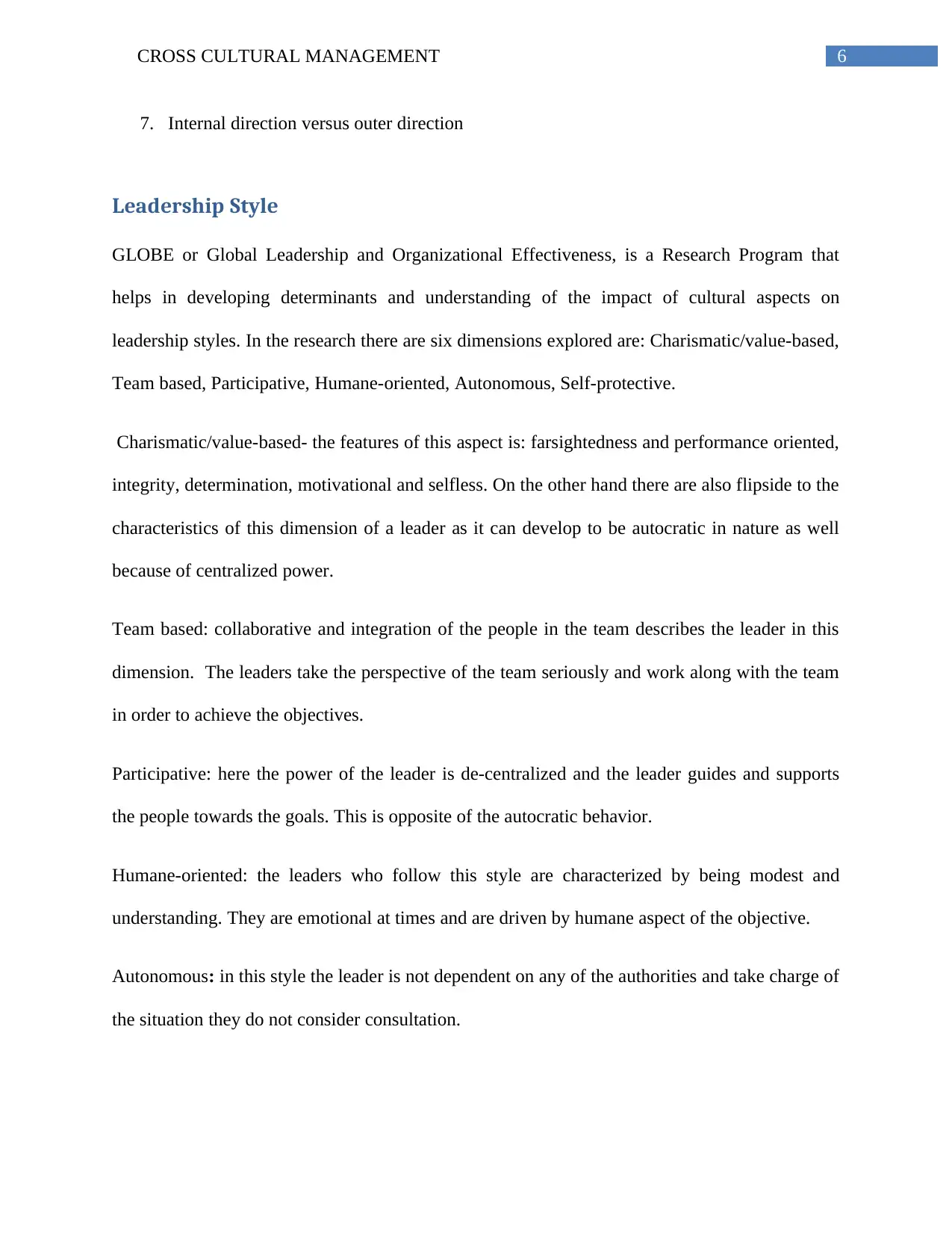
6CROSS CULTURAL MANAGEMENT
7. Internal direction versus outer direction
Leadership Style
GLOBE or Global Leadership and Organizational Effectiveness, is a Research Program that
helps in developing determinants and understanding of the impact of cultural aspects on
leadership styles. In the research there are six dimensions explored are: Charismatic/value-based,
Team based, Participative, Humane-oriented, Autonomous, Self-protective.
Charismatic/value-based- the features of this aspect is: farsightedness and performance oriented,
integrity, determination, motivational and selfless. On the other hand there are also flipside to the
characteristics of this dimension of a leader as it can develop to be autocratic in nature as well
because of centralized power.
Team based: collaborative and integration of the people in the team describes the leader in this
dimension. The leaders take the perspective of the team seriously and work along with the team
in order to achieve the objectives.
Participative: here the power of the leader is de-centralized and the leader guides and supports
the people towards the goals. This is opposite of the autocratic behavior.
Humane-oriented: the leaders who follow this style are characterized by being modest and
understanding. They are emotional at times and are driven by humane aspect of the objective.
Autonomous: in this style the leader is not dependent on any of the authorities and take charge of
the situation they do not consider consultation.
7. Internal direction versus outer direction
Leadership Style
GLOBE or Global Leadership and Organizational Effectiveness, is a Research Program that
helps in developing determinants and understanding of the impact of cultural aspects on
leadership styles. In the research there are six dimensions explored are: Charismatic/value-based,
Team based, Participative, Humane-oriented, Autonomous, Self-protective.
Charismatic/value-based- the features of this aspect is: farsightedness and performance oriented,
integrity, determination, motivational and selfless. On the other hand there are also flipside to the
characteristics of this dimension of a leader as it can develop to be autocratic in nature as well
because of centralized power.
Team based: collaborative and integration of the people in the team describes the leader in this
dimension. The leaders take the perspective of the team seriously and work along with the team
in order to achieve the objectives.
Participative: here the power of the leader is de-centralized and the leader guides and supports
the people towards the goals. This is opposite of the autocratic behavior.
Humane-oriented: the leaders who follow this style are characterized by being modest and
understanding. They are emotional at times and are driven by humane aspect of the objective.
Autonomous: in this style the leader is not dependent on any of the authorities and take charge of
the situation they do not consider consultation.
Paraphrase This Document
Need a fresh take? Get an instant paraphrase of this document with our AI Paraphraser
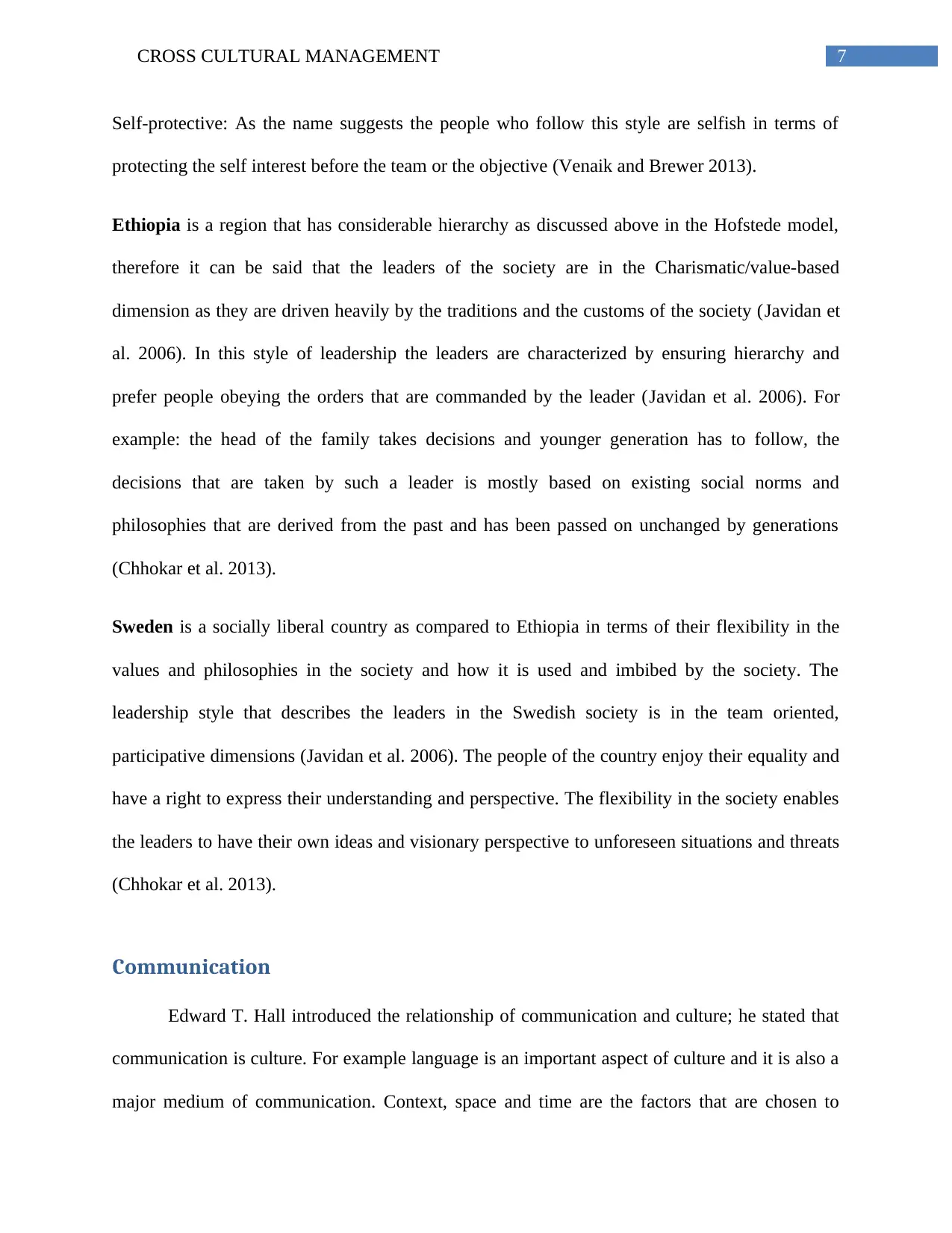
7CROSS CULTURAL MANAGEMENT
Self-protective: As the name suggests the people who follow this style are selfish in terms of
protecting the self interest before the team or the objective (Venaik and Brewer 2013).
Ethiopia is a region that has considerable hierarchy as discussed above in the Hofstede model,
therefore it can be said that the leaders of the society are in the Charismatic/value-based
dimension as they are driven heavily by the traditions and the customs of the society (Javidan et
al. 2006). In this style of leadership the leaders are characterized by ensuring hierarchy and
prefer people obeying the orders that are commanded by the leader (Javidan et al. 2006). For
example: the head of the family takes decisions and younger generation has to follow, the
decisions that are taken by such a leader is mostly based on existing social norms and
philosophies that are derived from the past and has been passed on unchanged by generations
(Chhokar et al. 2013).
Sweden is a socially liberal country as compared to Ethiopia in terms of their flexibility in the
values and philosophies in the society and how it is used and imbibed by the society. The
leadership style that describes the leaders in the Swedish society is in the team oriented,
participative dimensions (Javidan et al. 2006). The people of the country enjoy their equality and
have a right to express their understanding and perspective. The flexibility in the society enables
the leaders to have their own ideas and visionary perspective to unforeseen situations and threats
(Chhokar et al. 2013).
Communication
Edward T. Hall introduced the relationship of communication and culture; he stated that
communication is culture. For example language is an important aspect of culture and it is also a
major medium of communication. Context, space and time are the factors that are chosen to
Self-protective: As the name suggests the people who follow this style are selfish in terms of
protecting the self interest before the team or the objective (Venaik and Brewer 2013).
Ethiopia is a region that has considerable hierarchy as discussed above in the Hofstede model,
therefore it can be said that the leaders of the society are in the Charismatic/value-based
dimension as they are driven heavily by the traditions and the customs of the society (Javidan et
al. 2006). In this style of leadership the leaders are characterized by ensuring hierarchy and
prefer people obeying the orders that are commanded by the leader (Javidan et al. 2006). For
example: the head of the family takes decisions and younger generation has to follow, the
decisions that are taken by such a leader is mostly based on existing social norms and
philosophies that are derived from the past and has been passed on unchanged by generations
(Chhokar et al. 2013).
Sweden is a socially liberal country as compared to Ethiopia in terms of their flexibility in the
values and philosophies in the society and how it is used and imbibed by the society. The
leadership style that describes the leaders in the Swedish society is in the team oriented,
participative dimensions (Javidan et al. 2006). The people of the country enjoy their equality and
have a right to express their understanding and perspective. The flexibility in the society enables
the leaders to have their own ideas and visionary perspective to unforeseen situations and threats
(Chhokar et al. 2013).
Communication
Edward T. Hall introduced the relationship of communication and culture; he stated that
communication is culture. For example language is an important aspect of culture and it is also a
major medium of communication. Context, space and time are the factors that are chosen to
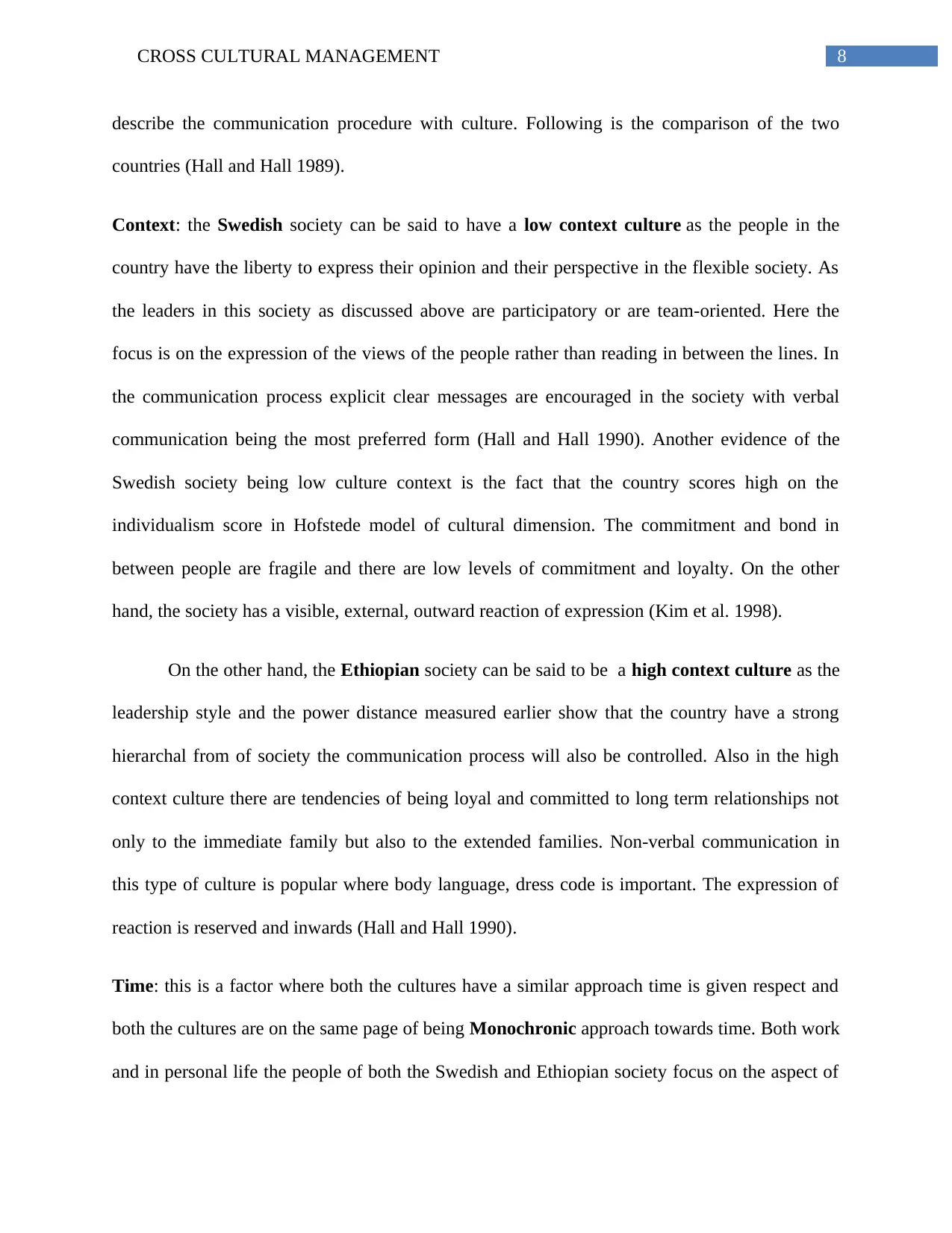
8CROSS CULTURAL MANAGEMENT
describe the communication procedure with culture. Following is the comparison of the two
countries (Hall and Hall 1989).
Context: the Swedish society can be said to have a low context culture as the people in the
country have the liberty to express their opinion and their perspective in the flexible society. As
the leaders in this society as discussed above are participatory or are team-oriented. Here the
focus is on the expression of the views of the people rather than reading in between the lines. In
the communication process explicit clear messages are encouraged in the society with verbal
communication being the most preferred form (Hall and Hall 1990). Another evidence of the
Swedish society being low culture context is the fact that the country scores high on the
individualism score in Hofstede model of cultural dimension. The commitment and bond in
between people are fragile and there are low levels of commitment and loyalty. On the other
hand, the society has a visible, external, outward reaction of expression (Kim et al. 1998).
On the other hand, the Ethiopian society can be said to be a high context culture as the
leadership style and the power distance measured earlier show that the country have a strong
hierarchal from of society the communication process will also be controlled. Also in the high
context culture there are tendencies of being loyal and committed to long term relationships not
only to the immediate family but also to the extended families. Non-verbal communication in
this type of culture is popular where body language, dress code is important. The expression of
reaction is reserved and inwards (Hall and Hall 1990).
Time: this is a factor where both the cultures have a similar approach time is given respect and
both the cultures are on the same page of being Monochronic approach towards time. Both work
and in personal life the people of both the Swedish and Ethiopian society focus on the aspect of
describe the communication procedure with culture. Following is the comparison of the two
countries (Hall and Hall 1989).
Context: the Swedish society can be said to have a low context culture as the people in the
country have the liberty to express their opinion and their perspective in the flexible society. As
the leaders in this society as discussed above are participatory or are team-oriented. Here the
focus is on the expression of the views of the people rather than reading in between the lines. In
the communication process explicit clear messages are encouraged in the society with verbal
communication being the most preferred form (Hall and Hall 1990). Another evidence of the
Swedish society being low culture context is the fact that the country scores high on the
individualism score in Hofstede model of cultural dimension. The commitment and bond in
between people are fragile and there are low levels of commitment and loyalty. On the other
hand, the society has a visible, external, outward reaction of expression (Kim et al. 1998).
On the other hand, the Ethiopian society can be said to be a high context culture as the
leadership style and the power distance measured earlier show that the country have a strong
hierarchal from of society the communication process will also be controlled. Also in the high
context culture there are tendencies of being loyal and committed to long term relationships not
only to the immediate family but also to the extended families. Non-verbal communication in
this type of culture is popular where body language, dress code is important. The expression of
reaction is reserved and inwards (Hall and Hall 1990).
Time: this is a factor where both the cultures have a similar approach time is given respect and
both the cultures are on the same page of being Monochronic approach towards time. Both work
and in personal life the people of both the Swedish and Ethiopian society focus on the aspect of
⊘ This is a preview!⊘
Do you want full access?
Subscribe today to unlock all pages.

Trusted by 1+ million students worldwide
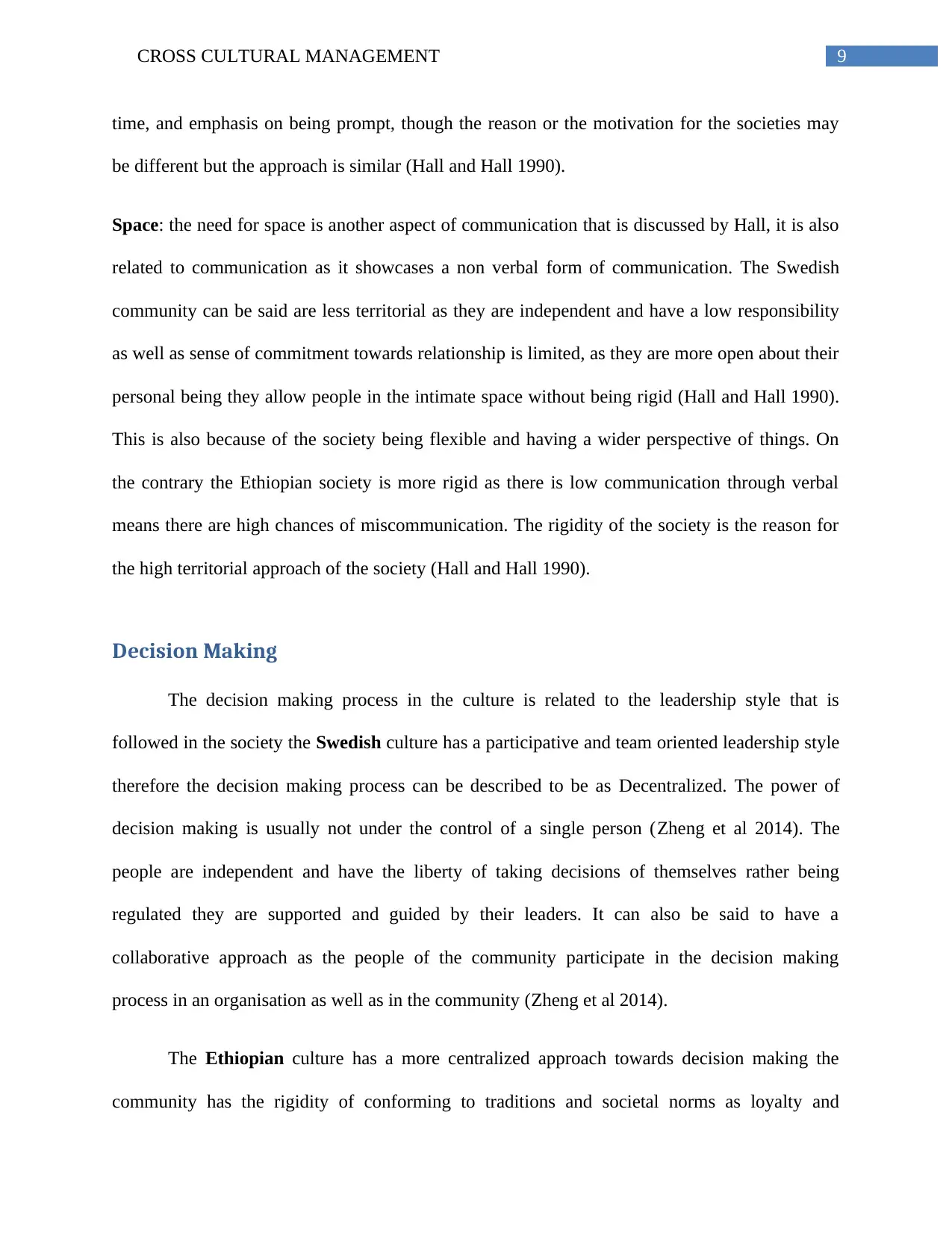
9CROSS CULTURAL MANAGEMENT
time, and emphasis on being prompt, though the reason or the motivation for the societies may
be different but the approach is similar (Hall and Hall 1990).
Space: the need for space is another aspect of communication that is discussed by Hall, it is also
related to communication as it showcases a non verbal form of communication. The Swedish
community can be said are less territorial as they are independent and have a low responsibility
as well as sense of commitment towards relationship is limited, as they are more open about their
personal being they allow people in the intimate space without being rigid (Hall and Hall 1990).
This is also because of the society being flexible and having a wider perspective of things. On
the contrary the Ethiopian society is more rigid as there is low communication through verbal
means there are high chances of miscommunication. The rigidity of the society is the reason for
the high territorial approach of the society (Hall and Hall 1990).
Decision Making
The decision making process in the culture is related to the leadership style that is
followed in the society the Swedish culture has a participative and team oriented leadership style
therefore the decision making process can be described to be as Decentralized. The power of
decision making is usually not under the control of a single person (Zheng et al 2014). The
people are independent and have the liberty of taking decisions of themselves rather being
regulated they are supported and guided by their leaders. It can also be said to have a
collaborative approach as the people of the community participate in the decision making
process in an organisation as well as in the community (Zheng et al 2014).
The Ethiopian culture has a more centralized approach towards decision making the
community has the rigidity of conforming to traditions and societal norms as loyalty and
time, and emphasis on being prompt, though the reason or the motivation for the societies may
be different but the approach is similar (Hall and Hall 1990).
Space: the need for space is another aspect of communication that is discussed by Hall, it is also
related to communication as it showcases a non verbal form of communication. The Swedish
community can be said are less territorial as they are independent and have a low responsibility
as well as sense of commitment towards relationship is limited, as they are more open about their
personal being they allow people in the intimate space without being rigid (Hall and Hall 1990).
This is also because of the society being flexible and having a wider perspective of things. On
the contrary the Ethiopian society is more rigid as there is low communication through verbal
means there are high chances of miscommunication. The rigidity of the society is the reason for
the high territorial approach of the society (Hall and Hall 1990).
Decision Making
The decision making process in the culture is related to the leadership style that is
followed in the society the Swedish culture has a participative and team oriented leadership style
therefore the decision making process can be described to be as Decentralized. The power of
decision making is usually not under the control of a single person (Zheng et al 2014). The
people are independent and have the liberty of taking decisions of themselves rather being
regulated they are supported and guided by their leaders. It can also be said to have a
collaborative approach as the people of the community participate in the decision making
process in an organisation as well as in the community (Zheng et al 2014).
The Ethiopian culture has a more centralized approach towards decision making the
community has the rigidity of conforming to traditions and societal norms as loyalty and
Paraphrase This Document
Need a fresh take? Get an instant paraphrase of this document with our AI Paraphraser
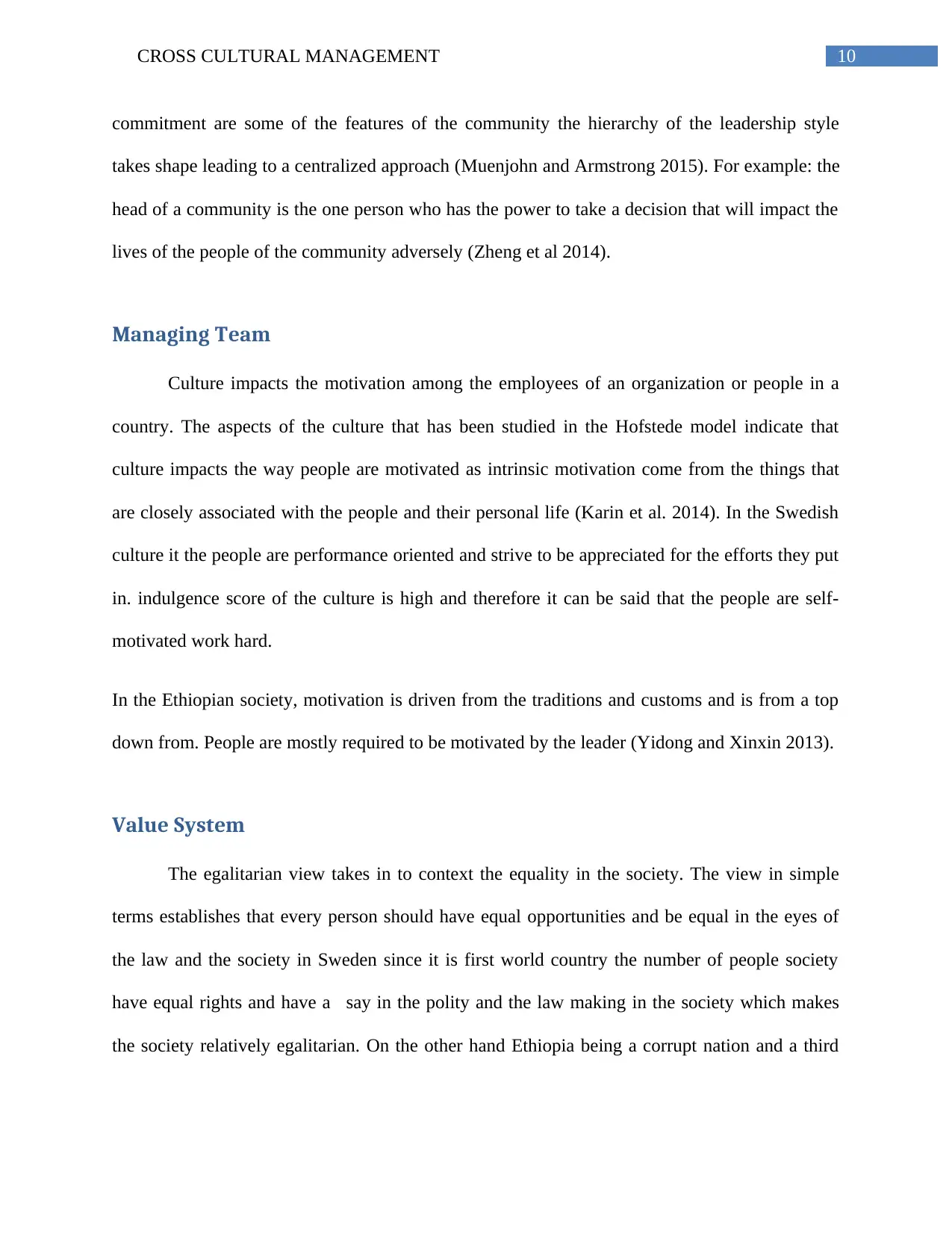
10CROSS CULTURAL MANAGEMENT
commitment are some of the features of the community the hierarchy of the leadership style
takes shape leading to a centralized approach (Muenjohn and Armstrong 2015). For example: the
head of a community is the one person who has the power to take a decision that will impact the
lives of the people of the community adversely (Zheng et al 2014).
Managing Team
Culture impacts the motivation among the employees of an organization or people in a
country. The aspects of the culture that has been studied in the Hofstede model indicate that
culture impacts the way people are motivated as intrinsic motivation come from the things that
are closely associated with the people and their personal life (Karin et al. 2014). In the Swedish
culture it the people are performance oriented and strive to be appreciated for the efforts they put
in. indulgence score of the culture is high and therefore it can be said that the people are self-
motivated work hard.
In the Ethiopian society, motivation is driven from the traditions and customs and is from a top
down from. People are mostly required to be motivated by the leader (Yidong and Xinxin 2013).
Value System
The egalitarian view takes in to context the equality in the society. The view in simple
terms establishes that every person should have equal opportunities and be equal in the eyes of
the law and the society in Sweden since it is first world country the number of people society
have equal rights and have a say in the polity and the law making in the society which makes
the society relatively egalitarian. On the other hand Ethiopia being a corrupt nation and a third
commitment are some of the features of the community the hierarchy of the leadership style
takes shape leading to a centralized approach (Muenjohn and Armstrong 2015). For example: the
head of a community is the one person who has the power to take a decision that will impact the
lives of the people of the community adversely (Zheng et al 2014).
Managing Team
Culture impacts the motivation among the employees of an organization or people in a
country. The aspects of the culture that has been studied in the Hofstede model indicate that
culture impacts the way people are motivated as intrinsic motivation come from the things that
are closely associated with the people and their personal life (Karin et al. 2014). In the Swedish
culture it the people are performance oriented and strive to be appreciated for the efforts they put
in. indulgence score of the culture is high and therefore it can be said that the people are self-
motivated work hard.
In the Ethiopian society, motivation is driven from the traditions and customs and is from a top
down from. People are mostly required to be motivated by the leader (Yidong and Xinxin 2013).
Value System
The egalitarian view takes in to context the equality in the society. The view in simple
terms establishes that every person should have equal opportunities and be equal in the eyes of
the law and the society in Sweden since it is first world country the number of people society
have equal rights and have a say in the polity and the law making in the society which makes
the society relatively egalitarian. On the other hand Ethiopia being a corrupt nation and a third
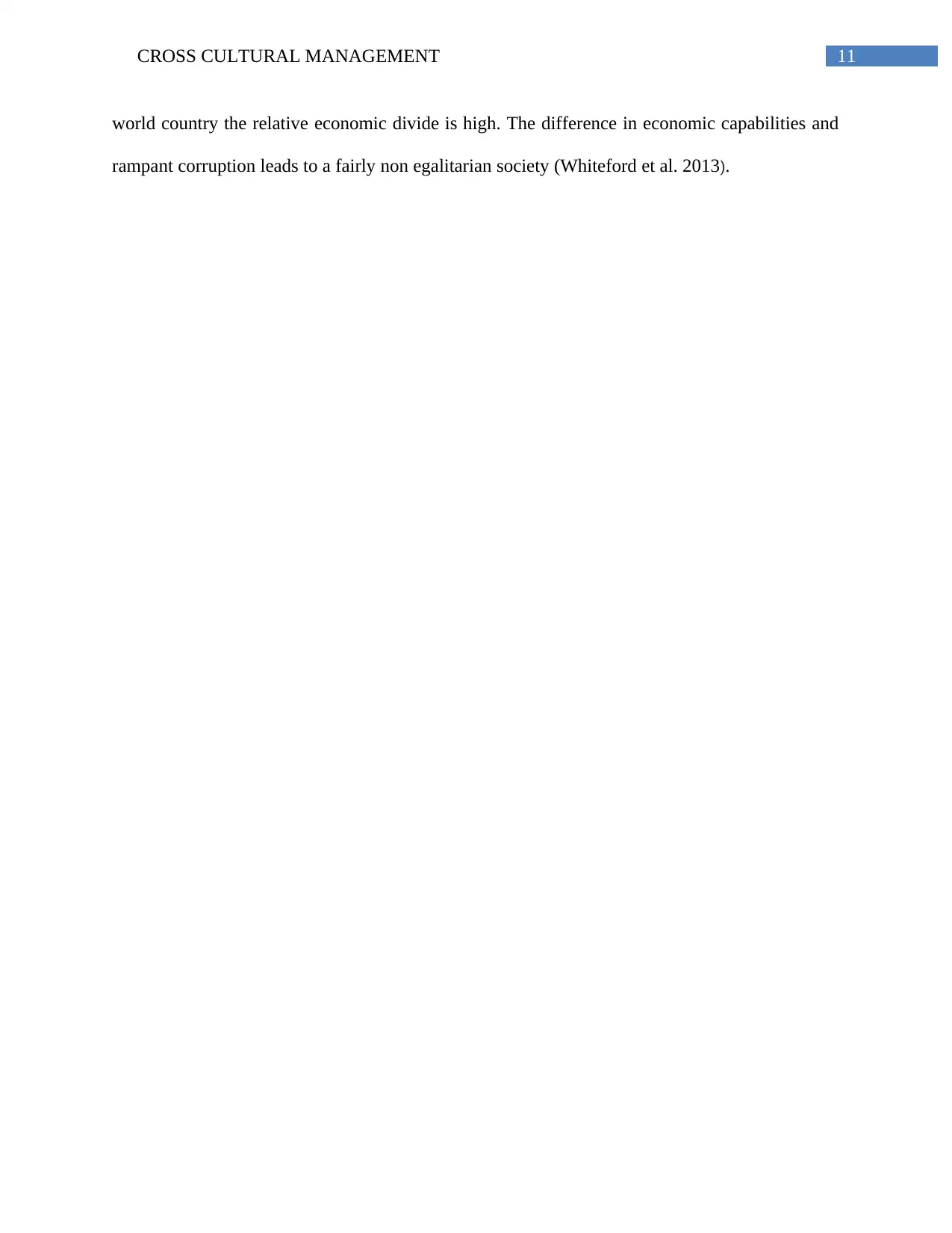
11CROSS CULTURAL MANAGEMENT
world country the relative economic divide is high. The difference in economic capabilities and
rampant corruption leads to a fairly non egalitarian society (Whiteford et al. 2013).
world country the relative economic divide is high. The difference in economic capabilities and
rampant corruption leads to a fairly non egalitarian society (Whiteford et al. 2013).
⊘ This is a preview!⊘
Do you want full access?
Subscribe today to unlock all pages.

Trusted by 1+ million students worldwide
1 out of 14
Related Documents
Your All-in-One AI-Powered Toolkit for Academic Success.
+13062052269
info@desklib.com
Available 24*7 on WhatsApp / Email
![[object Object]](/_next/static/media/star-bottom.7253800d.svg)
Unlock your academic potential
Copyright © 2020–2025 A2Z Services. All Rights Reserved. Developed and managed by ZUCOL.





